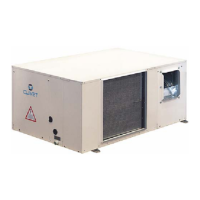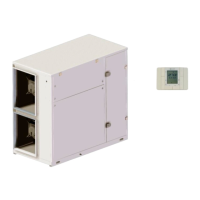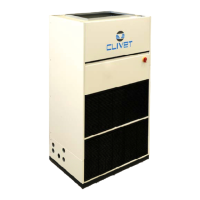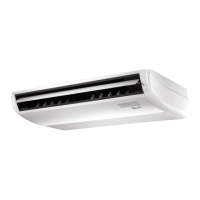
Do you have a question about the CLIVET CPAN-U-51 and is the answer not in the manual?
| Brand | CLIVET |
|---|---|
| Model | CPAN-U-51 |
| Category | Air Conditioner |
| Language | English |
Details about the serial number label, its location, and importance for unit identification.
Lists common reasons for the unit to stop operating.
Highlights additional safety measures and design solutions to prevent risks.
Lists potential hazards like burning smells, smoke, contact with hot parts, and improper panel closure.
Risks related to power supply, connections, grounding, and internal live parts.
Risks from refrigerant escaping, contact with flames, or overheating circuits.
Safety information and handling precautions for R-410A refrigerant.
Importance of air connections for unit operation and silence, considering pressure drops and airflow.
Table detailing electrical data such as voltage, FLA, LRA, FLI, and MIC for different unit sizes.
Step-by-step instructions for connecting the unit to the main power supply.
Refers to the wiring diagram for all connections and details remote control device usage.
Essential checks before starting up the unit, including installation and power supply.
Checks for air filters, ducting, dampers, grilles, and diffusers for proper air distribution.
Verification of the refrigerating circuit, oil stains, pressure, and service outlets.
Checks for the water circuit, filling, pressurization, seal tests, and air bleeding.
Verification of screw tightness, grounding, panel closure, voltage, and frequency.
Checking fluid temperatures, power supply tension, phase unbalance, and total absorption.
Checking the effective unit flow-rate and its relation to system characteristics.
Recording operational parameters like discharge temperature, pressure, and temperatures for monitoring.
Overview of the control panel interface, including buttons and indicators.
Explains how the unit manages incoming external air and ventilation based on temperature.
Details on manual and automatic selection of Heating/Cooling modes.
Manual and automatic ambient set-point adjustments and calculations.
Procedure to set the desired working setpoint.
How alarms are displayed and what they indicate.
How to scroll through active alarms.
Procedure for resetting active alarms.
Information regarding parameters accessible by service centers for calibration.
Crucial instruction to address the cause before resetting alarms to prevent damage.
Table detailing alarm codes, their meanings, and reset procedures.
Identifies the function of each button on the keypad.
Explains the meaning of various LED indicators on the keypad.
How to manually select Cooling or Heating mode using the keypad.
Steps for modifying parameters using the keypad.
Table listing accessible control parameters, mnemonic, value, and unit.
How alarms are displayed on the keypad and how to access the alarm log.
How to display and navigate through various unit status variables.
Table detailing status numbers, keypad status codes, and units of measurement.
Critical safety instruction to disconnect power before any maintenance or cleaning.
Importance of clean air filters for unit performance, health, and hygiene.
Specifies minimum inspection frequency and factors influencing it based on unit usage.
Lists the specific inspection tasks to be performed.
Definition and calculation method for overheating.
Definition and calculation method for subcooling.
Emphasizes troubleshooting by qualified personnel adhering to safety laws.
Crucial instruction to address alarm cause before resetting to prevent damage.
Warning about potential serious damage from repeated alarm resets.
Introduction to the list of potential alarm causes and their troubleshooting.











